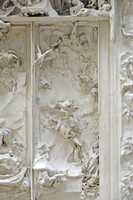Gates of Hell [original plaster model]
Rodin, Auguste

Download7A1-RA-GHM-A05_cp.jpg (408.7Kb)
Alternate file
Alternative Title
Porte de l'Enfer
Date
1880-1917Description
Detail, right panel of door; In August 1880, the Under-Secretary in the Ministry of Arts, Edmond Turquet (1836-1914), invited Rodin to provide monumental bronze doors for a planned new museum of decorative arts. It appears that it was Rodin’s decision to choose Dante’s Inferno as the theme for the doors that became known as the Gates of Hell. In 1885 Rodin announced that the Gates would be ready to be cast in six months. Plans for building the museum were soon canceled, however. Freed from a deadline, he let the work stand in his studio, intermittently revising the figure groups and architectural mouldings. In 1900 the plaster sections of the Gates, 6.35 m in height, were transported to a purpose-built pavilion in the Place de l’Alma, Paris, and shown for the first time to the public in an exhibition of 168 sculptures plus drawings and photographs organized by Rodin himself to coincide with the adjacent Exposition Universelle. Rodin’s masterpiece remained more or less untouched until after his death, when it was prepared for casting. The first bronze was made in 1925; there are a total of six bronzes. The original plaster in the Musée d’Orsay remains the property of the French government. Source: Grove Art Online; http://www.oxfordartonline.com/ (accessed 5/1/2014)
Type of Work
sculpture (visual work); doorSubject
allegory, human figure, literary or legendary, Dante Alighieri, 1265-1321, Divine Comedy, high-relief, Divina commedia, Nineteenth century, Twentieth century
Rights
Rights Statement
Licensed for educational and research use by the MIT community only